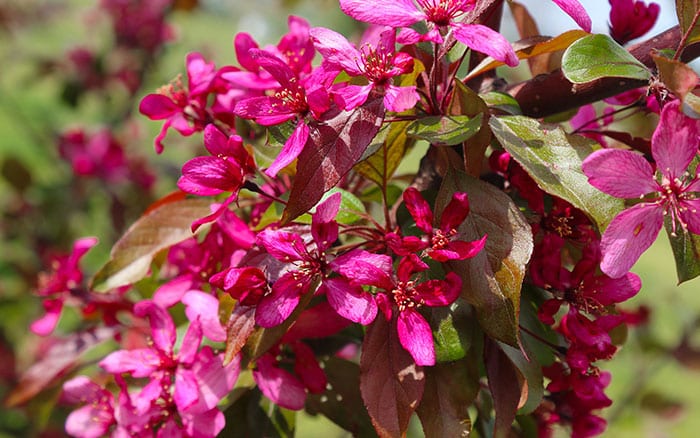One of the best ways that individuals can care for bees is to plant diverse plants that flower at different points of the year to increase the length of time that pollinators have access to them.
Bees are an incredibly important part of our ecosystems, with us depending on pollinators for much of our food. It’s estimated that one third of food is pollination dependent, so taking care of bees is vital for many reasons.
Spring
Malus (apple) ‘Royalty’
The spring blossom that blooms in April deep pink-red in colour, for a bit of drama in your garden. Pollinators will love the blooms, and the purple-red fruits that follow are popular with garden birds too. Not only do the flowers and fruits put on a show, but the foliage is stunning too, turning from purple to red through autumn.
- Flowers in spring
- Fully hardy
- Grows to 4m tall and 3m wide
- Moist but well-drained or well-drained soil
- Full sun or partial shade
- Exposed or sheltered

Crocus ‘Vanguard’
Early crocuses are some of the first blooms of the season, and this cultivar is a cheery addition that the bees will flock to. For a lovely effect of purple and white flowers with yellow centres, plant them in drifts in a sunny spot. Growing up to 10cm tall, they’ll look lovely at the front of a border where you can watch visiting bees.
- Flowers in spring
- Fully hardy
- Grows up to 10cm tall
- Well-drained soil
- Full sun
- Exposed or sheltered

Summer
Allium schoenoprasum (chives)
In the summer sun, the onion-scented foliage will be joined by rounded flowerheads of purple flowers. Their upright growth habit makes them look great grown near to ornamental grasses in a wildlife garden. When flowering has finished and the bees have been and gone, deadhead the flowers.
- Flowers in summer
- Fully hardy
- Grows up to 50cm tall
- Moist but well-drained or well-drained soil
- Full sun or partial shade
- Exposed or sheltered

Lavandula angustifolia (English lavender) ‘Imperial Gem’
With flowers through summer, long and short-tongued bumblebees, honeybees, solitary bees, and even butterflies will enjoy the purple blooms. This compact evergreen shrub will grow well in a container if you are short on space or want to attract bees to a balcony garden.
- Flowers in summer
- Hardy
- Grows up to 50cm tall
- Well-drained soil
- Full sun
- Sheltered

Autumn
Penstemon heterophyllus (penstemon) ‘Heavenly Blue’
The long flowering period of penstemons makes them great for providing for pollinators through the summer and autumn months. The tubular flowers that bees love have a similar appearance to foxgloves, so they are well suited to an informal or cottage style garden. Flowering until the first frosts, feed with an all-purpose fertiliser to give the blooms a boost.
- Flowers in summer and autumn
- Hardy through most of the UK
- Grows up to 50cm tall
- Moist but well-drained or well-drained soil
- Full sun or partial shade
- Sheltered

Aster thomsonii (Thomson’s aster)
Next are cheery perennials that have lavender rays that surround a bright yellow centre that are open and attractive to pollinators through summer and autumn. Growing up to 1m tall, they are hardy too which makes them suitable for coastal gardens.
- Flowers in summer and autumn
- Fully hardy
- Grows up to 1m tall
- Moist but well-drained or well-drained soil
- Full sun
- Exposed or sheltered

Winter
Mahonia japonica (Japanese mahonia)
This evergreen shrub is an all-round winner. From autumn to spring, the fragrant sprays of pale-yellow flowers bring colour to the garden, as well as attracting bees. Then, the flowers are followed by dark blue-black berries that add dramatic colour. Positioned in shade, this plant is great at giving architectural interest.
- Flowers from autumn to spring
- Hardy
- Grows up to 1.5m tall
- Moist but well-drained or well-drained soil
- Full shade or partial shade
- Exposed or sheltered

Lonicera fragrantissima (winter-flowering honeysuckle)
Another fragrant favourite for you to enjoy whilst bees enjoy the blooms. The cream flowers bloom in winter with a really delicate appearance. The bushy shrub grows up to 2m tall, so is a good contender for the back of the border.
- Flowers in winter
- Fully hardy
- Grows up to 2m tall
- Moist but well-drained or well-drained soil
- Full sun or partial shade
- Exposed or sheltered


Leave A Comment